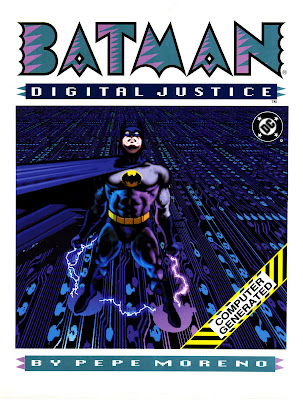
This is , without question, one of the stranger comic titles I’ve read in a while. BATMAN: DIGITAL JUSTICE is a 1990 graphic novel (“COMPUTER-GENERATED”, as a yellow-striped banner across the bottom of the cover reminds the reader) that’s pretty much batshit insane. Plot-wise, the book is set firmly in the realm of hard cyberpunk; futurized Gotham is basically one gigantic microchip, and the media and police are controlled by computers. There are “neo-skaters” and, an instance of startling prophecy, an extremely popular musician named “Gata” who wears ridiculous outfits and has amassed a legion of rapid fans. Jim Gordon’s grandson, also a cop, is tasked with protecting her “Bodyguard”-style, and is soon dragged into the aforementioned batshit insanity.
The plot’s little more than an overly-convoluted take on Blade Runner (and it shares a lot of similarities with the film “Lawmower Man”, though that was released two years after DIGITAL JUSTICE.) It’s about interesting to note that one of the main plot points, Joker being turned into a computer virus, was explored in the “Batman Beyond” series. I can’t help but wonder if Bruce Timm and company read this comic before crafting their take on Gotham’s far future.
Even though every page is packed with streams of techno jargon and clunky dialogue, “Digital Justice” is a captivating experience on a purely visual level. I can’t imagine how difficult it was for creator Pepe Moreno to craft a four-issue comic using early 90s computer technology, but his efforts paid off in spades. Every page in “Digital Justice” looks like it’s taken from a TurboGrafx-16 cutscene—trust me, that’s a compliment. The page layout is unique and the colors are eye-catching; Batman’s new costume and vehicle designs are more than a little goofy, but definitely fit the tone of the piece.
However, there are some drawbacks to Moreno’s choice to go all-digital. He re-uses the same JPEG too many times (I don’t care if you shaded it blue, IT’S THE SAME DAMN OFFICE BUILDING) and often repeats the same figure a half-dozen times to fill out a crowd. However, these are minor quibbles. Even if the plot’s a little too messy for its own good, DIGITAL JUSTICE is still a strong example of how early 90s artists tried to integrate programs like Photoshop with more traditional ways to tell comic book tales.